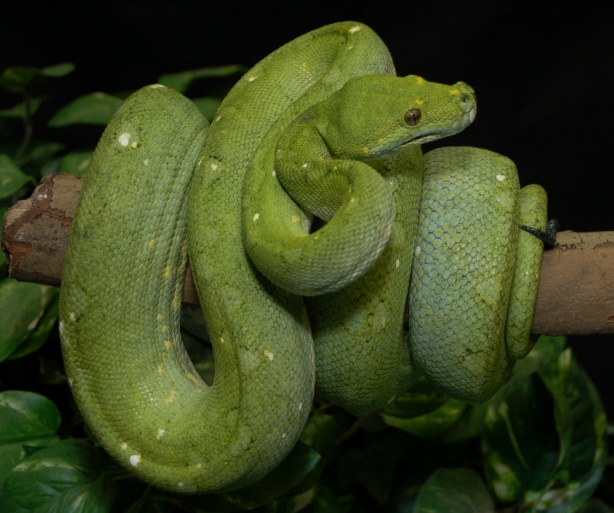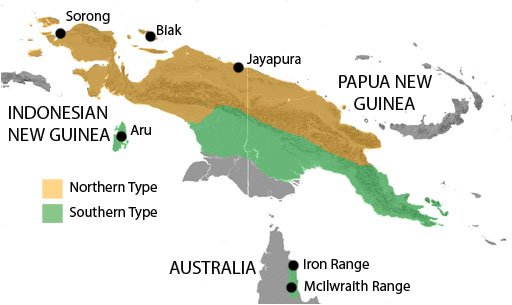Green Tree Python
Green Tree Python (Chondro Python)
Morelia (Chondropython) viridis


General Information
Family: Boidae
Locale: Papua & Irian Jaya, New Guinea, & Cape York Peninsula of Australia
Habitat: Highly arboreal, humid rainforest, from sea level to 6000ft
Average Size: 4 – 6’
Average Lifespan: Maybe >12 years
Activity: Nocturnal
Care Summary
Captive Care: 20 gal long aquarium (or larger) on end so lots of height, side-tank heating; custom cage with front opening door preferred (~18" x 18" x 24"H); humid forest terrarium with water for soaking, many horizontal and diagonal branches to coil on. Places to hide both on the ground and perches on branches. Mist animal daily.
Diet: Mice, rats chicks; hatchlings may need tease-feeding. In wild, eats small mammals and birds.
Temperature: Gradient of night time low of 70˚F (21˚C) to day time high of 90˚F (31˚C).
Temperament: Can be nippy, some are high strung and irascible, some will tame nicely with regular gently handling, but be prepared to be bitten if handle hatchlings with bare hands.
Notes:
- Require high humidity and misting so will drink.
- Typically rests coiled on branch like cinnamon bun.
- Spine easily damaged if removed from branch roughly.
- Hatchlings can be problem feeders, scenting mice with bird feathers may help with problem feeders.
- Hatchlings start out either bright yellow or brick red.
- Color change can occur within few weeks once started.
- Not a beginner’s snake.
References
Bartlett, P.P., Griswold, B., Bartlett, R.D. (2001). Reptiles, Amphibians, and Invertebrates, an identification and care guide. Barron’s Educational Series, Hauppauge, NY. 279pp.
Cogger, H. (2000). Reptiles & Amphibians of Australia, 6thed. Ralph Curtis Books, Sanibel Island, Florida. 808pp.
Kivit, R., Wiseman, S. (2000). The Green Tree Python & Emerald Tree Boa. Kirschner & Seufer Verlag, Keltern-Weiler, Germany. 127pp.
Maxwell, G. (2005). The More Complete Chrondo: a comprehensive guide to the care and breeding of the green tree python. ECO Herpetological Pub, Lansing MI. 317pp.
Ross, R. Marzec, G. (1990). The Reproductive Husbandry of Pythons and Boas. Institute for Herpetological Research, PO Box 2227, Stanford, CA 94305.
Range Map: http://greentreepythonsaustralia.com/types.html
Compiled by Eileen Underwood. Updated 9/2016.
The Herpetarium is a facility in the Department of Biological Sciences.
Bowling Green State University | Bowling Green, OH 43403-0001 | Contact BGSU Herpetarium | Campus Map
Updated: 02/25/2022 03:21PM

